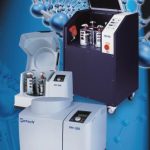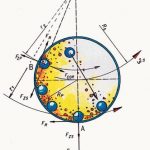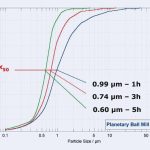Nanoparticles have come into the focus of science and industry due to their potential benefits in fields ranging from cancer treatment and food to environmental remediation. The challenge is: How to produce them on a consistent basis? Among the various techniques, planetary ball milling has established itself as a successful method of reducing larger particles to the required submicron size.
Frank Bath
All ball milling is carried out in a vessel or jar, into which is added the material to be ground, along with balls or other suitably shaped grinding elements that are made of the same material as the jar. Grinding takes place as a result of the interaction between the balls, particles and grinding jar wall, and the technique works equally well on soft, medium-hard and even extremely hard, brittle and fibrous materials. Unlike knife and rotor mills, where the moving element is fixed to the mill, the grinding balls or elements used in ball mills are free to move around during the grinding process, which gives the technique the ability to produce much finer particles. Generally speaking, smaller balls and longer grinding times are required to produce smaller particles.
One relatively simple version of a ball mill, the Centrifugal Ball Mill S 100, rotates a jar at controlled speeds around a central axis point. Planetary ball mills also use jars and grinding media, and operate on the same basic principle. One or more grinding jars can be used, with each occupying a station or planet that is mounted on a circular platform called a sun wheel. As the sun wheel turns, each of the planets, or grinding jars, also rotates on its own axis but in the opposite direction. This action rapidly accelerates the grinding balls through both centrifugal and Coriolis forces. As a result, the grinding energy is significantly increased, which allows even smaller particle sizes to be produced compared to other types of ball mills. The rapid acceleration of the particles from one side of the jar to the other produces powerful impact forces between the balls and sample material while also providing additional grinding action through frictional forces. For colloidal grinding and most other applications, the standard ratio between the rotational speed of the planets and the sun wheel is 1:-2.
To produce submicron or colloidal-sized particles, the grinding must be performed in a liquid medium. This is usually an alcohol (isopropanol or methanol), although other solvents and even water can be used in some applications. The presence of a liquid allows for better dispersion, thereby reducing agglomeration of the smaller particles, which can interfere with the grinding process.
Ensuring grinding success
Success or failure in colloidal grinding de-pends heavily on the grinding parameters used. These include the size of the grinding balls, the ratio of material to the grinding balls and liquid, and the grinding time and speed. In addition, a large number of small (typically 3 mm) grinding balls is used. Along with the liquid medium, the use of small balls virtually eliminates all impaction and employs primarily frictional forces to grind the material. As particles become smaller, they also become increasingly difficult to split; friction has proven to be one method that will reduce particle size in the colloidal size range.
Grinding jars and media for planetary ball milling can be obtained in a variety of different materials, including stainless steel, agate, tungsten carbide and various ceramic materials. For wet grinding, jars and media made from yttrium stabilized zirconium oxide (ZrO2) will produce the best results with minimal sample contamination. This particular ceramic is as close to a perfect grinding media as can be found, since it is both hard and tough, wears very slowly, is non-corrosive and has excellent surface characteristics. Although not considered brittle compared to other ceramic materials, ZrO2 will shatter if dropped or subjected to similar impact forces. Consequently, our high-quality yttriumstabilized ZrO2 grinding jars come with a stainless steel protective jacket. This feature also allows for the inclusion of other benefits, such as airtight seals and gripping rims, which make the jars both easy and safe to use.
While friction is a desired aspect of planetary ball mill grinding, it also generates a significant amount of heat, and therefore internal pressure, especially in processes such as colloidal grinding that require long grinding times. A tight seal between the jar and lid is therefore vital to prevent the sample and/or solvent from leaking out of the jar during grinding. As an added precaution and to prevent a dangerous sample/solvent loss when the jar is removed, the use of a safety clamping device is also recommended. This device ensures the complete security of the sample and the safety of the user, since the jar can only be opened when the safety clamp is removed (typically in a glove box or other secure area). After the material has been ground, it must be separated from the grinding balls. The easiest way to accomplish this task is to pour the wet material and grinding media mixture through a 7- or 8-mesh sieve (smaller than the 3 mm grinding balls) into a sieve collection pan. The sample can also be allowed to dry, using the Laboratory Dryer TG 100 if necessary. After the ma- terial is dry, the sieve and pan can be placed on the three-dimensional Sieve Shaker AS 200, and the vibratory effect will remove the vast majority of the remaining material from the grinding balls. This material will fall through the sieve and into the pan below, leaving behind the relatively clean grinding balls on the sieve. The grinding balls can then go through a final cleaning step in an Ultrasonic Bath to remove any remaining material.
A safe technology
Colloid particles sizes are achieved over hours of grinding. Such long grinding times demand that the mill be extremely well engineered and able to withstand constant vibration, while at the same time providing users with the versatility to handle many different sample types. Additionally, the mill must be equipped with adequate safety features, since it will have to be left unattended for long periods and used with potentially dangerous solvents. Retsch’s planetary ball mills convince by their powerful, sturdy drive concepts, stable, vibration-free operation and outstanding safety features. This, combined with their large range of accessories, has made them the mills of choice for the most demanding applications including mechanical alloying.
Hall 5.1, Booth D32
cpp 433
Mills from Retsch
Video about Planetary Ball Mills (RealPlayer)
Center for Nanotechnology
Share:









